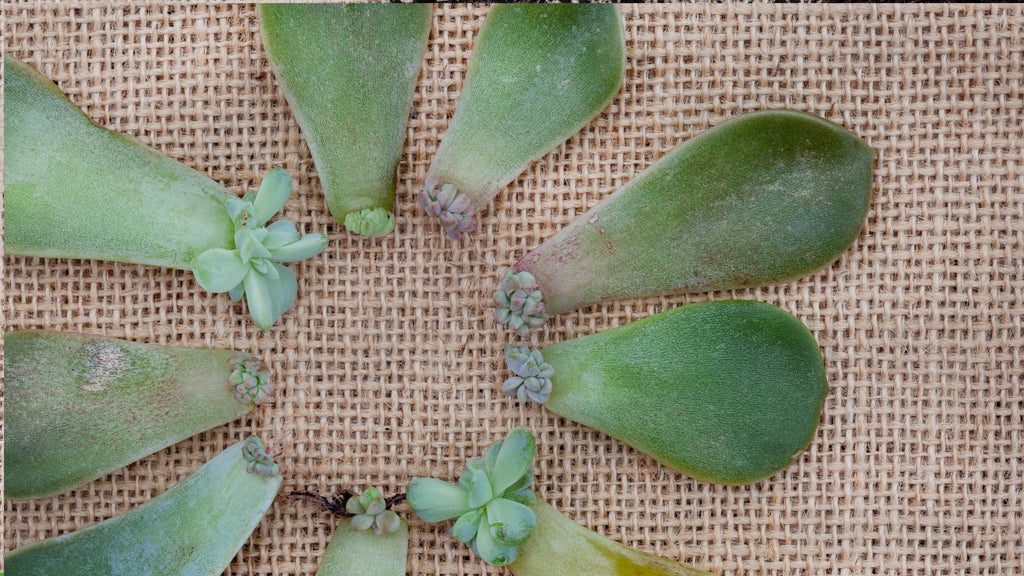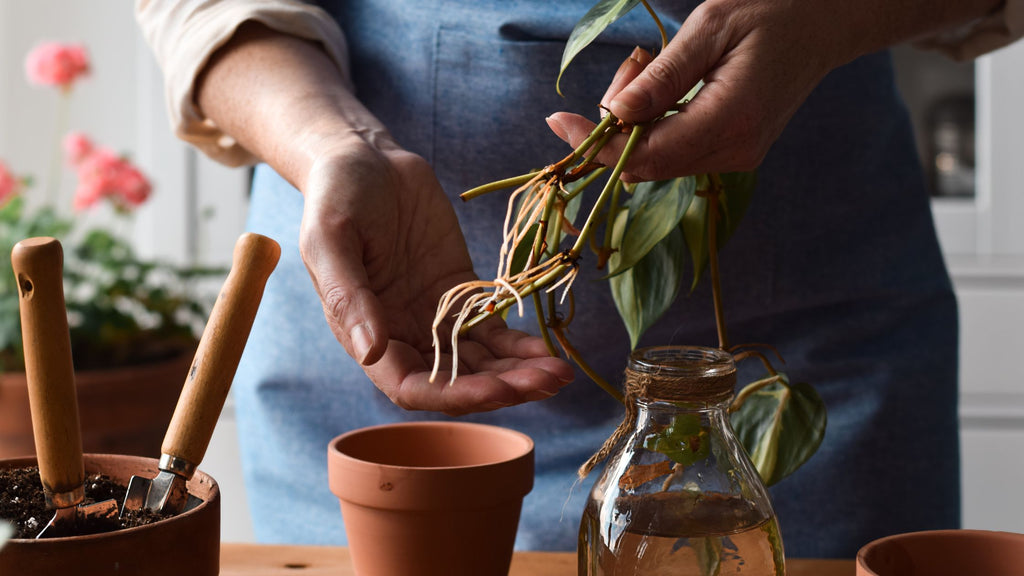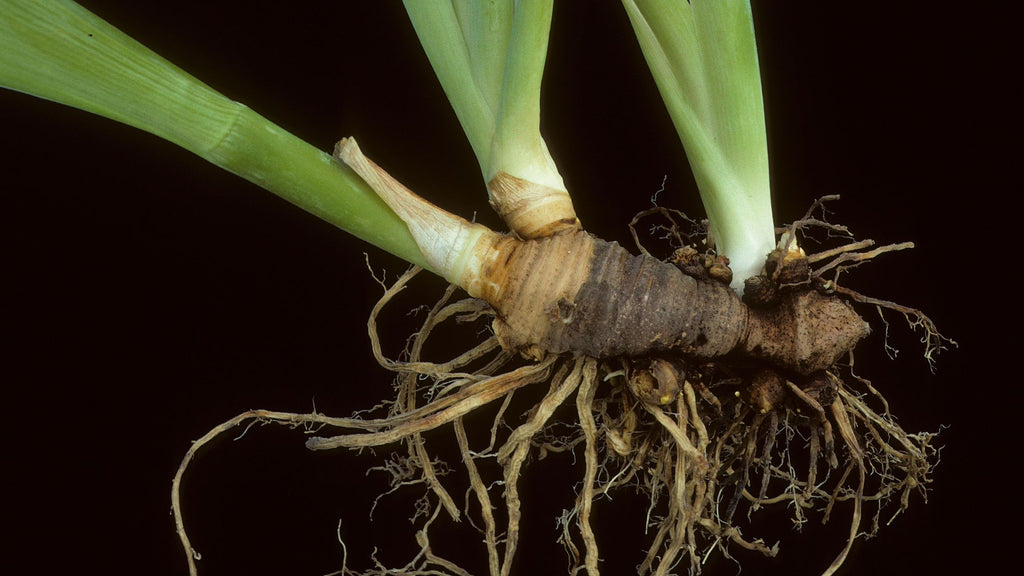
The Best Methods for Propagating Houseplants
Once you start filling your home with houseplants, adding to your collection can become a bit of an obsession. AMIRITE?
Just one more for that corner. And… oooooh…. I've always wanted a Pink Princess [or fill in the blank with whatever fun species is trending on IG or in your best friend's living room window].
Why we propagate houseplants
The savvy plant parent soon learns one of the best secrets to having more houseplants: propagation. Plant propagation is the process of producing a new plant from an existing one. The simple art of "chop and prop" (among other methods we'll discuss) can give you more plant babies without spending a single cent.
Sometimes, propagating houseplants becomes a necessary maintenance step when thriving but unruly plants need to be pruned to fit their indoor space. Other times, plant propagation gives a sad, dying plant another chance at life.
And of course, propagating houseplants not only gives YOU more plants but also creates new babies for you to gift to family and friends. What better present than a new plant friend?
There are many ways to propagate houseplants, some easier than others. Here at Southside Plants, we have some preferences for what works best. Let's explore what's possible.
The quick science of why plant propagation works - and doesn't work
Every plant cell possesses the necessary genetic information to produce a whole new plant. The nerdy term for this is totipotency.
But the cells need to be triggered in just the right way for this to happen.
Evolution plays a significant role in how totipotency expresses itself in different plants and explains why some plants can propagate from leaf cuttings and others cannot. These plants have evolved to respond to be able to grow plantlets when leaves are knocked off the mother plant into nearby soil.
An apple seed planted in the right conditions can sprout and eventually grow into an apple tree. A pothos cut for propagation triggers plant hormones to activate in the node, stimulating root growth and creating a new plant. Keiki paste provides plant hormones that stimulate growth at otherwise dormant nodes.
Sometimes, despite our best intentions and using correct methods, some propagations just don't make it - because the conditions just weren't quite right.
This article is another simple but comprehensive guide from the Master Gardener Program at the University of Wisconsin-Extension that covers plant hormones and propagation.
For more on the science of plant growth, read our post on the plant hormones auxin and cytokinin.
When is the best time to propagate houseplants?
A plant's optimal growing cycle is typically spring through summer. That said, a good time to propagate is any time your plants are actively growing since the conditions in your home may have sufficient light, warmth, and moisture for growth all year round—just like a tropical forest!
If you want to mimic ideal growing conditions in your home, consider adding grow lights during the times of year when sun rays are limited. You can put ones like these in your pots or even replace your regular lightbulbs (in a pendant lamp, for example) with grow light bulbs.
You may also want to relocate your plants to warmer areas of your home or add seedling mats under plants at the coldest times of the year.
For humidity, we recommend high-capacity humidifiers like this one. While spritzing can help, most houseplants prefer constant humid air over an occasional light mist in an otherwise dry climate.
Cuttings and most propagations prefer bright indirect light, so keep them out of direct sunlight.
Now that we know what conditions are best for propagating, let's examine all the methods you can choose from.
The best methods for houseplant propagation
While nerding out about plant propagation, we've learned this topic is way more complex than throwing a cutting in a jar of water. If you're interested, this article by NC State Extension goes into depth about all the different ways plants can be reproduced.
Since we are houseplant people, we will be focusing on the best methods for indoor houseplant propagation with the following methods:
- Cuttings of stems and leaves
- Air Layering
- Division for plants with rhizomes, corms, and bulbs
- Growing rare plants from tissue culture
- Propagating with keiki paste

Propagating plants with cuttings
Propagating houseplants with cuttings is the easiest and most rewarding methods of making more plants from the ones you already have.
Some of the best houseplants to propagate with stem cuttings include vines (like pothos, philodendron, monstera, and hoya) and upright plants with nodes (like ficus and polka dot begonia).
Other plants (like succulents, snake plants, African violets, and peperomias) can be propagated by leaf, petiole, or vein cutting.
Understanding the techniques and general rules will set you up for success, so we have created a separate guide for propagating houseplants with cuttings (both stem and leaf).

Propagation by air layering
Air layering is a propagation method in which the bark of a plant's main stem or trunk is partially removed, and a propagation medium—usually sphagnum moss—is applied and then covered to create a humid compartment. Roots form at the plant's wound.
Air layering is gaining popularity on social media as a method for propagating houseplants that can be stubborn to root with the typical "chop and prop" method. The beloved fiddle leaf fig and many ficus respond favorably to air layering.
One of the benefits of air layering is that you do not have to "behead" your plant, which often leaves an unsightly specimen.
Check out our post - coming soon - on how to air layer a fiddle leaf fig!
 Propagation by division and offsets
Propagation by division and offsets
If you know about plant nodes, you know that all plants have nodes somewhere because this is where growth occurs. If you don't know about nodes yet, read this post.
Some plants have nodes above ground (like all vines and trees that branch out of a central stem). Other plants possess underground nodes in fleshy plant parts collectively known as geophytes—individually called rhizomes, bulbs, tubers, or corms. These plants can be propagated by separating their underground parts.
Division and separation can propagate many houseplants with rhizomes. Common examples include:
- Aloe
- Agave
- Birds of Paradise
- Bromeliads
- Calathea
- Ferns
- Hen and Chicks
- Orchids
- Palms
- Peace Lily
- Pilea peperiomoides - Chinese money plant
- Snake plants (also propagate by cutting)
- Spider Plants (also put out above-ground pups)
- Zz Plants (also propagate by cutting)
How to propagate houseplants with rhizomes
- Choose a plant with rhizomes. Remove from container.
- Lay the plant on its side. Use your hands and fingers to gently loosen the root ball and separate the plant into smaller pieces. If necessary, use a knife or saw to separate the rhizome, ensuring each section has a healthy section of rhizome, roots, leaves, and stem. The larger the piece, the faster it will recover.
- Repot the sections with fresh potting soil (we recommend our Ropey Root Potting Mix)

Propagating houseplants with corms and bulbs
Plants with bulbs and corms naturally separate when these structures grow from a clump. Two common houseplants with corms are alocasias and colocasias. Houseplants with bulbs include Caladium and Oxalis.
To propagate houseplants with corms or bulbs, you can either wait for a new sprout to emerge from the soil or harvest the corms or bulb offsets when repotting your plant and propagate them in a high-humidity setting.
See our post on propagating alocasia from corms - coming soon!
The geophytes not mentioned here are tubers. While you might commonly think of potatoes, flowers like dahlias and peonies actually possess tubers, but this type of geophyte is not common for indoor houseplants.

Growing houseplants from tissue culture
Tissue culture is an advanced technique of plant propagation that clones a plant in a sterile environment under controlled conditions.
For home hobbyists, growing houseplants from tissue culture can be a fun way to experiment with rare and expensive plant varieties without investing in full-grown specimens.
Tissue culture plants are grown in sealed containers with 100% humidity. When you receive a tissue-cultured plant, it needs to adapt gently over 1-2 days to local humidity, temperature, and other factors. The plantlets will be covered in a gel medium that needs to be thoroughly cleaned off before planting.
Here's a great post with videos demonstrating how to acclimate your plantlets grown from tissue culture.
Best propagation mediums
Root medium is whatever substance you put your cutting in to grow. Different species will root better in different mediums, so you may want to experiment with several mediums simultaneously for comparison.
While some cuttings, like succulents and cacti, can thrive directly in soil, the best rooting mediums for most cuttings are water, perlite, or sphagnum moss.
Water is the simplest and most affordable, but the downside is that some cuttings or plantlets easily rot in water. Sphagnum moss and perlite retain moisture but also hold many air pockets that prevent cuttings from rotting.
Some houseplant hobbyists like to propagate in leca, pon or other hydroponic soil alternatives. There is no right or wrong choice, only what works for you and your propagation goals.
When it's time to transfer baby plants into soil, we recommend starting with our Delicate Root Potting Mix.

Propagating with cloning paste
Keiki Paste is a product used by orchid aficionados and houseplant lovers to generate new growth at the node of a plant. For most houseplants, this doesn't make a new plant; instead, it fills in bare stems where leaves have fallen off or not developed. For orchids, however, keiki paste can be used to clone and propagate entirely new plants. Learn how to grow new orchids with keiki paste in this post.
We hope you've found this post on propagating houseplants helpful! What's your favorite way to propagate? What method do you want to try next?

